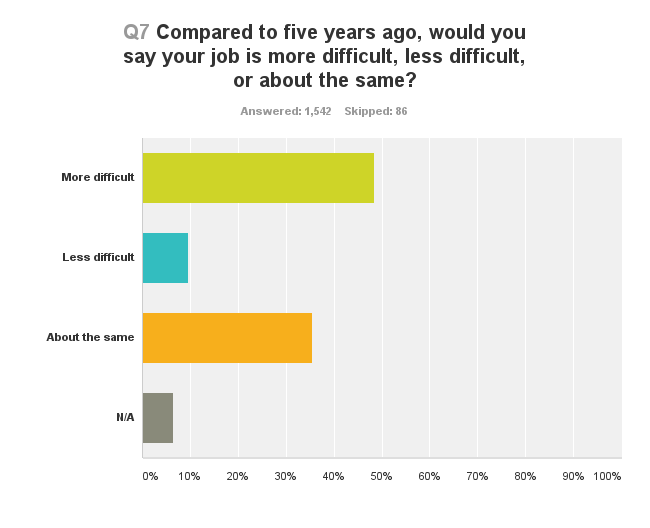Perhaps no other word has been as popular in higher education during the past few years as the term “flipped.” As a result, there is no shortage of ideas and opinions about flipped learning environments. Some faculty consider it another way to talk about student-centered learning. Others view flipped classrooms as an entirely new approach to teaching and learning. Still others see flipping as just another instructional fad that will eventually run its course.
Read more ›CURRENT ARTICLE • August 24
OTHER RECENT ARTICLES
Flipped learning environments offer unique opportunities for student learning, as well as some unique challenges. By moving direct instruction from the class group space to the individual students’ learning spaces, time and space are freed up for the class as a learning community to explore the most difficult concepts of the course. Likewise, because students are individually responsible for learning the basics of new material, they gain regular experience with employing self-regulated learning strategies they would not have in an unflipped environment.
Read More ›If you’re a regular reader of this blog, you’re already aware that flipped instruction has become the latest trend in higher education classrooms. And for good reason. As it was first articulated by Bergmann and Sams, flipped instruction personalizes education by “redirecting attention away from the teacher and putting attention on the learner and learning.” As it has evolved, the idea of flipped instruction has moved beyond alternative information delivery to strategies for engaging students in higher-level learning outcomes. Instead of one-way communication, instructors use collaborative learning strategies and push passive students to become problem solvers by synthesizing information instead of merely receiving it. More recently on this blog, Honeycutt and Garrett referred to the FLIP as “Focusing on your Learners by Involving them in the Process” of learning during class, and Honeycutt has even developed assessments appropriate for flipped instruction. What's been left out of the conversation about flipped classrooms, however, is why and how we might also need to flip assessment practices themselves.
 Professor Philip LaRocco is reimagining his Energy Business and Economic Development course with digitized lecture materials, collaborative assignments, and real-time feedback. With funding from Columbia University’s Office of the Provost, LaRocco teamed up with the Columbia Center for New Media Teaching and Learning (CCNMTL) to build a learning environment more conducive to the world in which his students currently intern, and plan to work in post-graduation. He is following a “flipped classroom” model—filming some of his lectures and making them available to students prior to class meetings—making way for more elaborate group review, discussions, and other collaborative assignments during class.
Professor Philip LaRocco is reimagining his Energy Business and Economic Development course with digitized lecture materials, collaborative assignments, and real-time feedback. With funding from Columbia University’s Office of the Provost, LaRocco teamed up with the Columbia Center for New Media Teaching and Learning (CCNMTL) to build a learning environment more conducive to the world in which his students currently intern, and plan to work in post-graduation. He is following a “flipped classroom” model—filming some of his lectures and making them available to students prior to class meetings—making way for more elaborate group review, discussions, and other collaborative assignments during class.
 The flipped learning model of instruction has begun to make the transition from an educational buzzword to a normative practice among many university instructors, and with good reason. Flipped learning provides many benefits for both faculty and students. However, instructors who use flipped learning soon find out that a significant amount of work is sometimes necessary to win students over to this way of conducting class. Even when the benefits of flipped learning are made clear to students, some of them will still resist. And to be fair, many instructors fail to listen to what students are really saying.
The flipped learning model of instruction has begun to make the transition from an educational buzzword to a normative practice among many university instructors, and with good reason. Flipped learning provides many benefits for both faculty and students. However, instructors who use flipped learning soon find out that a significant amount of work is sometimes necessary to win students over to this way of conducting class. Even when the benefits of flipped learning are made clear to students, some of them will still resist. And to be fair, many instructors fail to listen to what students are really saying.
Blended learning has gone from being an interesting new hybrid of traditional and online courses to being an expected part of American education. When the Sloan Consortium last studied blended learning in 2007, it found “a lot of room for growth” in the market for blended courses. It found “consumer preference for online and blended delivery far exceeds reported experience,” indicating that demand was ahead of supply at that point.
Read More ›I have some concerns about flipping courses. Maybe I’m just hung up on the name—flipping is what we do with pancakes. It’s a quick, fluid motion and looks easy to those of us waiting at the breakfast table. I’m not sure those connotations are good when associated with courses and that leads to what centers my concerns. I keep hearing what sounds to me like “flippant” attitudes about what’s involved.
Read More ›Putting Students in the Driver's Seat: Technology Projects to Decrease Passivity
 Passivity still seems to be the norm for most college courses: students passively try to learn information from teachers who unwittingly cultivate a passive attitude in their learners. As the subject matter experts, many faculty are reluctant to give up some control. We know the material, there’s a lot to cover, and let’s face it, going the lecture route is often just plain easier for everyone. We “get through” the material, and students aren’t pressed to do anything more than sit back and take notes. Teacher and student thus become complicit in creating a passive learning environment.
Passivity still seems to be the norm for most college courses: students passively try to learn information from teachers who unwittingly cultivate a passive attitude in their learners. As the subject matter experts, many faculty are reluctant to give up some control. We know the material, there’s a lot to cover, and let’s face it, going the lecture route is often just plain easier for everyone. We “get through” the material, and students aren’t pressed to do anything more than sit back and take notes. Teacher and student thus become complicit in creating a passive learning environment.
 A few weeks ago, a colleague emailed me about some trouble she was having with her first attempt at blended instruction. She had created some videos to pre-teach a concept, incorporated some active learning strategies into her face-to-face class to build on the video, and assigned an online quiz so she could assess what the students had learned. After grading the quizzes, however, she found that many of the students struggled with the concept. “Maybe,” she wondered, “blended instruction won’t work with my content area.”
A few weeks ago, a colleague emailed me about some trouble she was having with her first attempt at blended instruction. She had created some videos to pre-teach a concept, incorporated some active learning strategies into her face-to-face class to build on the video, and assigned an online quiz so she could assess what the students had learned. After grading the quizzes, however, she found that many of the students struggled with the concept. “Maybe,” she wondered, “blended instruction won’t work with my content area.”
Nearly 75 Percent of Faculty Incorporated Technology into their Teaching in the Past Year
When it comes to technology in the classroom, phrases like “faculty resistance” and the importance of getting “faculty buy-in” are tossed around with great frequency. But is that perception still valid? Are all instructors so set in their ways, skeptical of anything new, and fearful of deviating from what they’ve done that it’s nearly impossible to get them to try something new?
Read More ›






